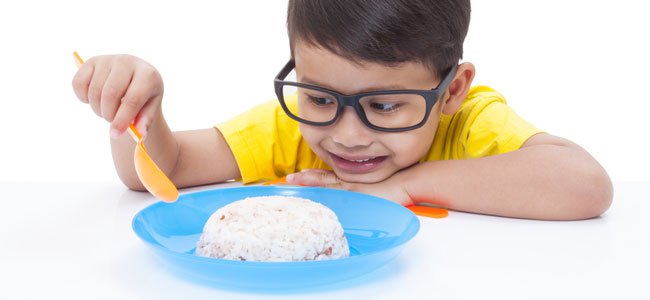2 Healthier Alternatives to Replace Sugar in Children's Foods


Written and verified by the nutritionist Saúl Sánchez Arias
Did you know that you can replace sugar in your children’s food as a way to prevent many diseases and ensure a healthier life? Although the taste buds of the tongue have the function of identifying flavors (bitter, sweet, salty, sour), it’s the brain that’s in charge of processing this information and deciding what we like.
However, neuronal plasticity in its dynamism during childhood allows us to vary our perception of flavors, modulating our appetite. As parents are the ones in charge of preparing the meals that children eat, we’re the ones who “educate” their taste for the palatability of foods.
Why do humans like sweet foods?

The glucose that comes with sweet foods is used by cells as an energy source and becomes the primary fuel that the body needs to function.
The taste for sweet foods comes from metabolism. And as you may have noticed, it becomes a need.
2 Healthier alternatives to replace sugar in children’s food
You should know that fruits are rich in fructose. Just by giving your child juices, smoothies, or offering fruits naturally, you’re already incorporating the sugars they need in their diet.
However, if your desire is to increase the sweetness of foods to stimulate their sense of taste and not deprive them of such a pleasant flavor, we recommend two healthier alternatives to replace sugar.
Honey
Honey is rich in glucose, and as an additive, it’s an excellent food to sweeten children’s desserts. A single spoonful is enough to fulfill this purpose.
This product, in addition to its sweetness, has appreciable properties that prevent and alleviate common ailments during childhood. In any case, avoid offering this product to children under 1 year of age, otherwise, they could develop a disease known as infant botulism, as experts state. This problem affects health in a severe way.
Among the properties of honey, we can’t fail to mention the following:
- It’s antimicrobial: It prevents the proliferation of bacteria, fungi, viruses, and parasites.
- It helps to counteract coughs and sore throats.
- It helps to heal and prevent infections in wounds and minor burns.
- Its glucose composition makes it a powerful natural energizer.
- It relieves the discomfort of the common cold.
- It’s a natural source of vitamins and minerals.
Stevia rebaudiana
Stevia rebaudiana, popularly called stevia, as well as honey, is sweeter than refined sugar. It’s a caloric artificial sweetener, which won’t produce weight gain. This doesn’t mean that it can be consumed without limits. A study published in the journal Food and Chemical Toxicology associates the abuse of artificial sweeteners with dysfunctional changes in the microbiota. For this reason, it should be taken in moderation.
Stevia leaf extract, as a sweetener, is available in both liquid and powder form and sometimes in small tablets. Another option may be saccharin, which has similar properties.
Nutritional recommendation. A dessert without sweetener or added sugar

We want to emphasize that it’s always better to offer children natural foods with no added sugar; however, if you’re going to add sweeteners, it’s preferable to use alternatives such as honey and stevia, rather than refined sugar.
Finally, we want to offer you this delicious rice pudding dessert recipe that your child will love. Just follow the steps we recommend so you’ll see that you don’t need sugar in its preparation.
Ingredients:
- 3 tablespoons of rice.
- 1 liter of cow’s milk.
- ½ liter of water.
Preparation
Put the 3 tablespoons of rice to soften under pressure with ½ liter of water. Allow it to cook for 15 to 20 minutes.
Pour the liter of milk into another container and heat it over the stove so that it boils and then the water in the milk evaporates. Give it approximately 15 minutes after it starts to boil.
Next, pour the rice and the water from the other container into the pot with the milk and let it continue to cook. Every now and then, you’ll have to stir it so that it doesn’t stick.
Your dessert is ready when you see that it becomes thick, sweet, and yellowish.
Use alternatives to replace sugar
The best thing you can do for children’s health is to restrict the consumption of refined sugar. This way, they won’t feel the need for it during adulthood. In addition, their metabolism won’t be affected, and the incidence of diabetes and obesity will be reduced. Remember that the best time to instill good habits is during childhood. Don’t waste this opportunity.
Did you know that you can replace sugar in your children’s food as a way to prevent many diseases and ensure a healthier life? Although the taste buds of the tongue have the function of identifying flavors (bitter, sweet, salty, sour), it’s the brain that’s in charge of processing this information and deciding what we like.
However, neuronal plasticity in its dynamism during childhood allows us to vary our perception of flavors, modulating our appetite. As parents are the ones in charge of preparing the meals that children eat, we’re the ones who “educate” their taste for the palatability of foods.
Why do humans like sweet foods?

The glucose that comes with sweet foods is used by cells as an energy source and becomes the primary fuel that the body needs to function.
The taste for sweet foods comes from metabolism. And as you may have noticed, it becomes a need.
2 Healthier alternatives to replace sugar in children’s food
You should know that fruits are rich in fructose. Just by giving your child juices, smoothies, or offering fruits naturally, you’re already incorporating the sugars they need in their diet.
However, if your desire is to increase the sweetness of foods to stimulate their sense of taste and not deprive them of such a pleasant flavor, we recommend two healthier alternatives to replace sugar.
Honey
Honey is rich in glucose, and as an additive, it’s an excellent food to sweeten children’s desserts. A single spoonful is enough to fulfill this purpose.
This product, in addition to its sweetness, has appreciable properties that prevent and alleviate common ailments during childhood. In any case, avoid offering this product to children under 1 year of age, otherwise, they could develop a disease known as infant botulism, as experts state. This problem affects health in a severe way.
Among the properties of honey, we can’t fail to mention the following:
- It’s antimicrobial: It prevents the proliferation of bacteria, fungi, viruses, and parasites.
- It helps to counteract coughs and sore throats.
- It helps to heal and prevent infections in wounds and minor burns.
- Its glucose composition makes it a powerful natural energizer.
- It relieves the discomfort of the common cold.
- It’s a natural source of vitamins and minerals.
Stevia rebaudiana
Stevia rebaudiana, popularly called stevia, as well as honey, is sweeter than refined sugar. It’s a caloric artificial sweetener, which won’t produce weight gain. This doesn’t mean that it can be consumed without limits. A study published in the journal Food and Chemical Toxicology associates the abuse of artificial sweeteners with dysfunctional changes in the microbiota. For this reason, it should be taken in moderation.
Stevia leaf extract, as a sweetener, is available in both liquid and powder form and sometimes in small tablets. Another option may be saccharin, which has similar properties.
Nutritional recommendation. A dessert without sweetener or added sugar

We want to emphasize that it’s always better to offer children natural foods with no added sugar; however, if you’re going to add sweeteners, it’s preferable to use alternatives such as honey and stevia, rather than refined sugar.
Finally, we want to offer you this delicious rice pudding dessert recipe that your child will love. Just follow the steps we recommend so you’ll see that you don’t need sugar in its preparation.
Ingredients:
- 3 tablespoons of rice.
- 1 liter of cow’s milk.
- ½ liter of water.
Preparation
Put the 3 tablespoons of rice to soften under pressure with ½ liter of water. Allow it to cook for 15 to 20 minutes.
Pour the liter of milk into another container and heat it over the stove so that it boils and then the water in the milk evaporates. Give it approximately 15 minutes after it starts to boil.
Next, pour the rice and the water from the other container into the pot with the milk and let it continue to cook. Every now and then, you’ll have to stir it so that it doesn’t stick.
Your dessert is ready when you see that it becomes thick, sweet, and yellowish.
Use alternatives to replace sugar
The best thing you can do for children’s health is to restrict the consumption of refined sugar. This way, they won’t feel the need for it during adulthood. In addition, their metabolism won’t be affected, and the incidence of diabetes and obesity will be reduced. Remember that the best time to instill good habits is during childhood. Don’t waste this opportunity.
All cited sources were thoroughly reviewed by our team to ensure their quality, reliability, currency, and validity. The bibliography of this article was considered reliable and of academic or scientific accuracy.
- Committee on toxicity of chemical in food, consumer products and environment. Discussion paper on potential risks from various sweeteners in the diet of infants aged 6 to 12 months and children aged 1 to 5 years. TOX/2019/36.
- Food Data Central. Dates, medjool. Departamento de Agricultura de Estado Unidos. Abril 2019.
- Gómez Fernández-Vegue M. Recomendaciones de la Asociación Española de Pediatría sobre la alimentación complementaria. Comité de Lactancia Materna y Comité de Nutrición de la Asociación Española de Pediatría. Noviembre 2018.
- Lobach AR., Roberts A., Rowland IR., Assessing the in vivo data on low/no calorie sweeteners and the gut microbiota. Food Chem Toxicol, 2019. 124: 385-399.
- Organización Mundial de la Salud (OMS). Ingesta de azúcares para niños y adultos. 2015.
- Paglia L, Friuli S, et al. The effect of added sugars on children health outcomes: obesity, obstructive sleep apnea syndrome (OSAS), Attention-defycit/Hiperactivity disorder (ADHD) and chronic diseases. Intedisciplinary Update. 2019.
- Saraiva A, Carrascosa C, et al. Natural sweetener: the relevance of food naturalness for consumers, food security aspects, sustainability and health impacts. International Journal of Environmental Research and Public Health. Septiembre 2020. 17 (17): 6285.
- Wikstrom S., Holst E., Infant botulism – why honey should be avoided for children up to one year. Lakartidningen, 2017.
This text is provided for informational purposes only and does not replace consultation with a professional. If in doubt, consult your specialist.








